8+ Sample Release Management Plan
-
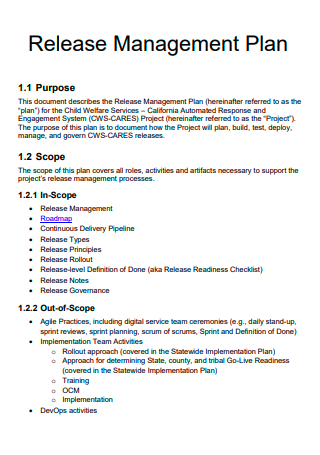
Release Management Plan Template
download now -
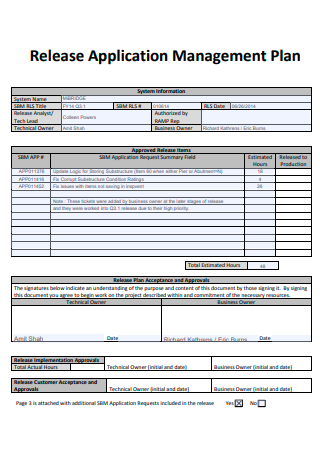
Release Application Management Plan
download now -
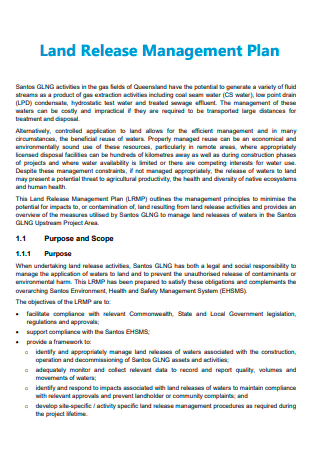
Land Release Management Plan
download now -
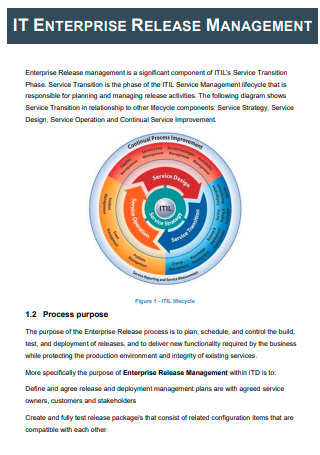
IT Enterprise Release Management Plan
download now -
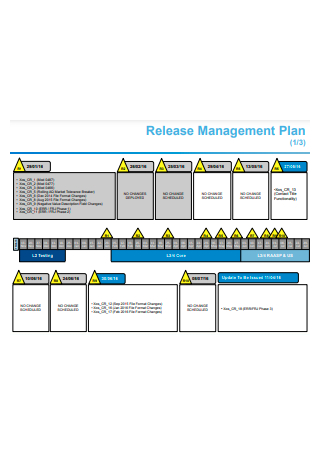
Release Management Plan Example
download now -
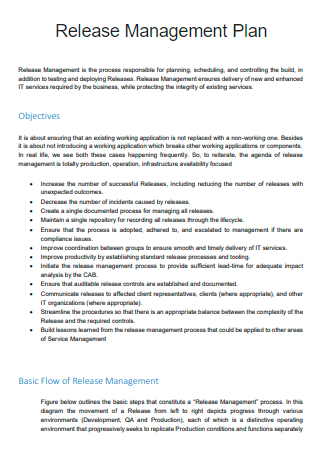
Printable Release Management Plan
download now -
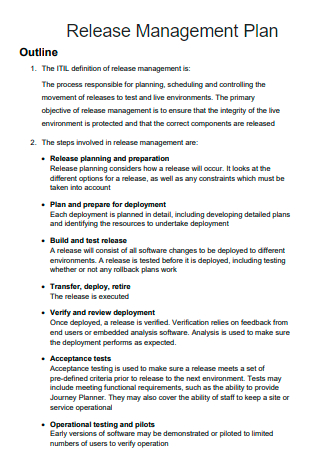
Release Management Plan Outline
download now -
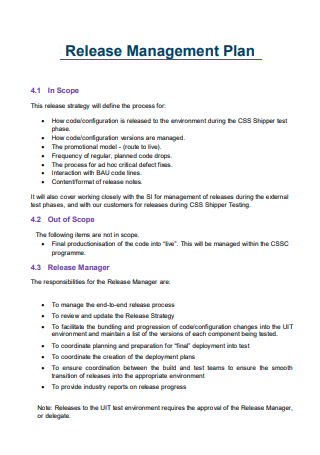
Standard Release Management Plan
download now -
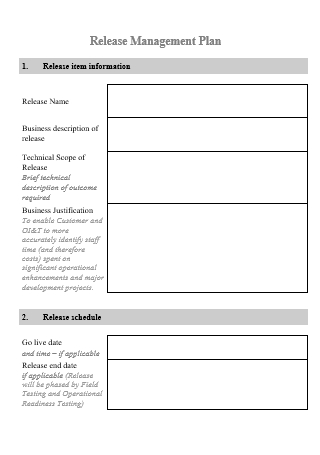
Release Management Plan in DOC
download now
FREE Release Management Plan s to Download
8+ Sample Release Management Plan
What Is a Release Management Plan?
Key Terms in Release Management
Release Management Methods
How To Implement the Release Management Plan
FAQs
What is a release plan?
What is a release checklist?
What are the responsibilities of a release manager?
What Is a Release Management Plan?
A release management plan contains the processes of planning, designing, testing, scheduling, controlling, and deploying software. It guarantees that the team responsible for releasing software effectively delivers the necessary upgrades to applications that the business needs while maintaining the integrity of the current production environment. Across the organization, it schedules relevant internal and external tasks, assigns various resources to carry out activities, and oversees the execution of assignments. Release management utilizes different techniques like agile development, continuous delivery, DevOps, and release automation to optimize the process. Release management is a relatively new discipline in software engineering, and it is growing rapidly due to swift technological innovations and advancements. As a specialization, it stems from traditional and business-focused project management and technical knowledge of the system development life cycle (SDLC) and the IT infrastructure systems, including IT practices for service management. Since software systems, resources, and processes are well-distributed in different sectors and industries, software inevitably becomes more complex that require areas of specialization. Release management focuses on ongoing developments, testings, and releases of these applications.
According to an Amazon article published on their website regarding their deployment tools, there is an established pilot program focusing on the software delivery systems for several teams within the organization. Throughout the program, the headlining pilot team possesses incredible numbers of 90 percent reduction in their overall time to go through the systems from check-in to production.
Key Terms in Release Management
To better understand the release management process, there are several terms that an individual must know when creating the release management plan. Below are some of the terminologies widely used in the document. It is best to be aware of them to know when and how you can use them.
Release Management Methods
There are various ways that an organization can go about performing its software release. Many companies utilize two methods, namely, agile development and waterfall development. While different, they have similar results. The option for choosing one over the other depends on the complexity of the software and the scope of the involved teams. The section below details these methodologies.
How To Implement the Release Management Plan
The release management plan consists of a lifecycle that has five distinct phases that include planning, building, testing, preparing, and deploying the software to live operations of the update. It is critical to follow the stages of release management as it properly organizes and executes successful releases. The guide below helps you understand the stages of release management.
-
1. Release Planning Stage
The initial step to launching software is to plan with the primary stakeholders on the development team. Each task of the planning stage helps the release manager to execute a systematic development plan. In this phase of release management, it is best to communicate with the operations and leadership teams for the approval of the software build to continue with its development. Prepare a release management planning checklist that contains the processes of the planning stage. Start connecting with stakeholders by sending them a project summary report before the first meeting. During the first meeting, the release manager must communicate more details about the project, including objectives and success metrics. The next step is to write a business case that elaborates on the value and impact of the project, including its long-term benefits. Establish a work breakdown structure that visualizes the project in a more digestible format for stakeholders. Submit the software plan for approval, and plan the release schedule as necessary.
-
2. Release Building Stage
After completing the release management checklist, the second phase is the most time-intensive to the development team; the release building stage. In this step, stakeholders are aware of their tasks and responsibilities and accomplish the communication of project details. After all of these, the development team starts building the software and simultaneously testing and improving its performance and features. It’s also advantageous to begin tracking potential risks or bugs in systems or applications as preparation for testing. As part of the checklist, make sure to communicate with stakeholders, identify project dependencies, create a risk register, initiate problem-solving initiatives, introduce new features in the operating environment, and automate initial testing.
-
3. Release Testing Stage
The next stage of the release management cycle is the testing phase. It ensures that the software runs properly, making it ready for launch. Start the software testing method by having team members identify and resolve issues and implement end-user acceptance testing. User testing depends on how complex the development team completed the software release, but it provides an opportunity for the consumer market to test software for their critical feedback, and in return, they can have rewards. During this stage, the development team also performs regression testing that involves rechecking approved functionality by verifying its performance. When it comes to software, testing becomes time-consuming if there are several modifications.
-
4. Release Preparing Stage
When preparing for a software release, the team must accomplish and complete all the necessary changes while optimizing the functionality in a testing environment. Doing this guarantees that each part of the software performs properly and is ready for live implementation. Perform multiple quality assurance checks to ensure the overall functionality of the software. The team members or the manager is responsible for conducting the quality assurance checking, and it is advisable to get members from another team for a fresh perspective on the software. After the final review and approval, the organization can deploy the software to a live environment.
-
5. Release Deployment Stage
The final stage of the release management process is the software deployment management stage. In this step, the manager executes the initial software idea and moves it to a more functional and live environment. Before the software deployment, the development team must conduct more testing to guarantee the preservation of functionality in a live setting. After all the retesting processes are complete, the development team must continually evaluate software integrations and make the adjustments necessary to improve its functionality. Only close the project tasks once the software is on the live environment and all the essential integrations are complete.
FAQs
What is a release plan?
A release plan is a tactical business plan that captures and tracks features of the software for an impending release. A release plan usually spans for a few months and is an internal working document for the development, operating, and product teams.
What is a release checklist?
A release management checklist contains all software development stages with their corresponding tasks. The stages of software development in the list include product management, development phase, quality assurance, DevOps, reverse engineering, and configuration, technical support, and release management. The tasks in each step involve the creation, ideation, and approval processes.
What are the responsibilities of a release manager?
The role of a release manager involves planning a release lifecycle and managing involved risks in the scope of the release. They are also responsible for communicating the project plans, commitments, and changes. The release manager also shoulders the responsibility of measuring and monitoring project progress and ensures the delivery of releases within the due date and budget plan.
A release management plan is necessary for an organization to grow and develop. Innovating software takes time, resources, and communication from different members of the development, operation, and production teams. As such, the release manager carries a variety of responsibilities to ensure that the release management cycle goes smoothly. Without the release management plan, there is no clear roadmap on engaging with various processes. Create a release management plan for your business by downloading the samples available in the article above.
